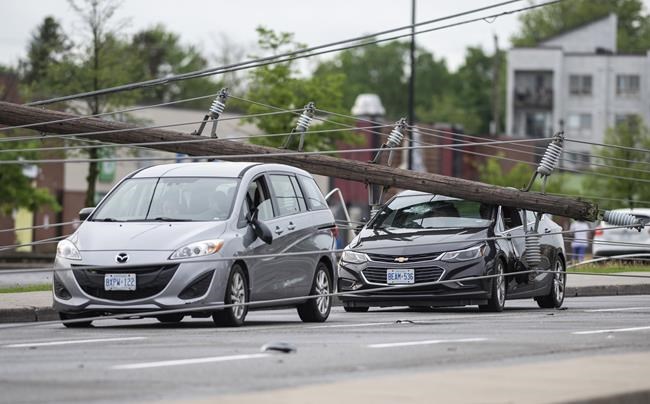The first long weekend of the summer season began in tragic fashion in Ontario on Saturday after a powerful storm killed at least three people in its swift but intense path across the southern part of the province.
Tens of thousands of residents also found themselves without power, according to utility Hydro One, whose outage map showed roughly 1,700 outages leaving more than 350,000 people in the dark as of Saturday evening.
The first death came in the city of Brampton, Ont., west of Toronto, where Peel Regional Police said a woman in her 70s was out walking when the storm sprang up in the early afternoon. She was struck and killed by a tree, police said.
Further west, Ontario Provincial Police said one person was killed and two others were injured when a tree fell on a camping trailer near Pinehurst Lake in Waterloo Region.
And police in Ottawa said late Saturday that one person died in the city's west end, but they didn't release any further details.
"I am very sad to learn about the tragic deaths of two people in Ontario as a result of the severe weather today," Ontario Premier Doug Ford said in an evening tweet before news of the Ottawa death was confirmed. "My thoughts go out to both of their families & friends and I offer condolences on behalf of all Ontarians."
Three other people suffered non-life-threatening injuries after trees fell on two golf carts in Zora Township, the OPP noted in a separate tweet.
Trees and power lines were knocked down across a swath of the province stretching from Sarnia to Ottawa by ferocious winds, which at one point reached 132 km/h at the Kitchener, Ont. airport.
The Environment Canada weather station at Toronto Pearson International Airport measured gusts of 121 km/h when the storm blew through the city at noon.
"It was like being in a carwash," said West Ottawa resident Mike Edgerton, who noted the storm hit five minutes after he received an alert.
Kristina Martin said she was at home with her dog in the Old Ottawa South neighbourhood when the storm began.
"The lightning and the storm took down tons of power lines and tons of these big beautiful trees, which was pretty sad to see. It was definitely dramatic and everyone I know is safe," she said.
Joseph Muglia, director of Hydro Ottawa, said more than 179,000, or about half their customers, across the city had lost power.
"It's still early in trying to try to establish what exactly we're dealing with here. We're probably dealing with a multi-day event," he told a news conference with the city's mayor and emergency officials.
Pierre Poirier, Ottawa's paramedic chief, said two people were critically injured at golf courses and one person was seriously injured in a car crash.
The storm was severe enough for Environment Canada to issue a broadcast-intrusive emergency alert that went out to television and radio stations and mobile phones.
Environment Canada meteorologist Daniel Liota said the storm was unusual in that it covered such a large geographic area.
"It was a big deal. It's your upper echelon of thunderstorms," he said in a telephone interview.
Mark Robinson, a forecaster, meteorologist and storm chaser for the Weather Network, said the storm took many experts by surprise because there usually isn't enough heat and energy in the late morning or early afternoon, and he noted many computer models didn't pick it up.
Robinson said the storm could be classified as a derecho event, which he said has to cause damage for 450 kilometers and have winds roughly in the 120 km/h range.
"The trees that were around me were roaring as the wind came through, and I haven't heard that outside of a hurricane, so that's how strong these winds were. I've been through 23 hurricanes, so I'm sort of used to that sound."
The storm eventually made its way to Quebec, where it also left thousands of residents without power.
Hydro Quebec's website showed about 357,000 customers without electricity as of 6 p.m., mainly in the Outaouais region in Western Quebec and the Laurentians area north of Montreal. Residents in Lanaudière, northeast of Montreal, were also affected.
Earlier Saturday, tornado warnings were issued for several regions in southern and central Quebec.
Liota noted that severe thunderstorms were only recently added to the alert system.
According to Alert Ready, which runs the warning system for Canadian governments, a severe thunderstorm warning has not gone out on the system in the four years of data listed.
To trigger a broadcast-intrusive alert for thunderstorms, there needs to be measured winds of at least 130 kilometres an hour, or hail of at least seven centimetres in diameter, which is about the size of a tennis ball, said Liota.
This report by The Canadian Press was first published May 21, 2022.
— With files from Ian Bickis and Maan Alhmidi in Toronto, Brieanna Charlebois in Vancouver and Sidhartha Banergee in Montreal
The Canadian Press



